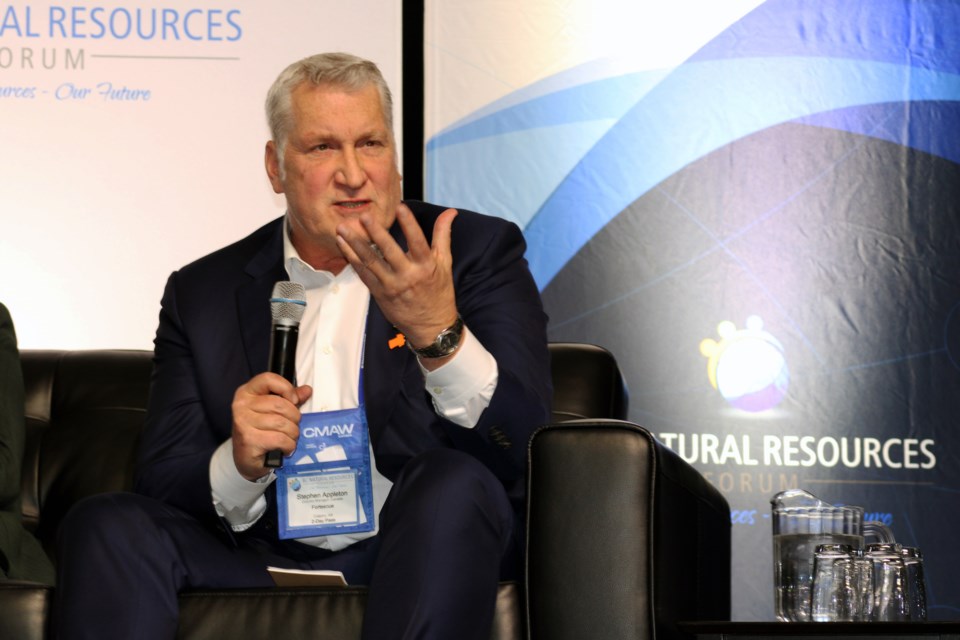As Canada country manager for Australian mining giant, Fortescue Future Industries, Stephen Appleton has big plans for Prince George.
His Coyote Project, to build a hydrogen export plant in the Willow Cale Industrial Park in the Boundary Road area west of the airport, would create a facility large enough to annually produce 140,000 tonnes of hydrogen and 700,000 tonnes of ammonia.
For something that big, to use hydrolysis to split that many water molecules into one part oxygen and two parts hydrogen, will require about a thousand megawatts of electricity. That’s almost as much as the entire generating capacity of Site C dam when it starts producing power.
“It aligns with so many things that have been talked about, whether it’s from Ottawa, Victoria or Prince George, and that is it’s clean,” said Appleton, who spoke at the BC Natural Resources Forum Wednesday at the Prince George Confernence and Civic Centre.
“Prince George can serve as the vanguard. We’re talking about gamechanger in terms of moving the needle with regards to climate objectives and producing a significant amount of product that can essentially populate the entire province.
“We intend to build in an area that has challenges with regards to airshed and we intend to bring in a project that has no emissions and it will bring economic development to the tune of our early estimates of $1.2 billion in cascading business opportunities over the 25 years of the design life.”
Coyote would create about 350 direct jobs and triple that number from supporting industries in the region and because it depends on renewable resources, unlike other industrial sectors Appleton says there’s really no end in sight to how long can can produce its products.
“It’s not a matter of when the formation runs out of gas, it’s not matter of when we’ve mined the copper it’s gone,” he said. “All it requires is sustaining capital, preventative maintenance and we have all the ingredients from water, to nitrogen, to make this plant create a green product.
Whether Coyote and the massive amounts of electricity it will need ever gets greenlighted remains to be seen. Introduced to the provincial government in late September, the project is in the early engagement stage of environmental assessment.
Based in Calgary, Appleton first came to Prince George in March 2021 and by October of that year the company had an initial memorandum of understanding agreement in place with the Lheidli T’enneh First Nation.
He focused on British Columbia for the project because of its abundant water sources and its current capacity to produce electricity. Fortescue considered 20 sites in the province before deciding where it wants to build the plant. The city’s location close to the airport at the hub of major highways and railways corridors made Prince George the right geographic choice.
UNBC and its undergraduate and graduate programs, combined with the College of New Caledonia’s vocational programs will provide the skilled workforce needed to operate the plant. Appleton said Fortescue would also bring in workers from other resource projects that will soon be coming to an end.
The proposed site is close to the Williston substation on Cummings Road, a major component of the province’s electrical grid. To keep railcars carrying ammonia he said the CN yards downtown and its maintenance division will provide support.
“You can move the product by rail in three potential directions (west, east and south) and it all comes together here,” Appleton said. “The B.C. government has declared Prince George as a hydrogen hub and the synergistic effect should make people excited.”
“The (Prince Rupert Port Authority) deliberately made mention to shift away from being a coal export hub to a green ammonia export hub so it only makes sense that we link the two.
“I don’t want to underestimate there are a number of moving parts with this project because its complex. There’s a number of communities along the right of way that CN moves freight by and we haven’t started that (consulting) process because we want to be certain before we engage them. It’s incumbent upon us to talk about it.”



